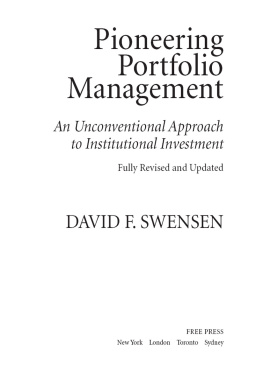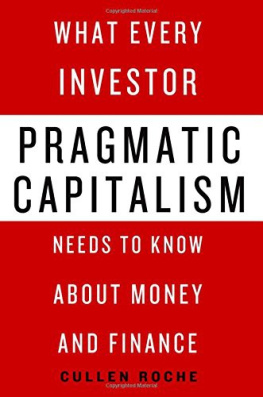Table of Contents
For other titles in the Wiley Finance series
please see www.wiley.com/finance
This edition first published 2012
2012 Lukasz Snopek
Translated by Jessica Edwards from the original French edition: Guide Complet de Construction et de Gestion de Portefeuille published in 2010 by Maxima Laurent du Mesnil Editeur, Paris.
Registered office
John Wiley & Sons Ltd, The Atrium, Southern Gate, Chichester, West Sussex, PO19 8SQ, United Kingdom
For details of our global editorial offices, for customer services and for information about how to apply for permission to reuse the copyright material in this book please see our website at www.wiley.com.
The right of the author to be identified as the author of this work has been asserted in accordance with the Copyright, Designs and Patents Act 1988.
All rights reserved. No part of this publication may be reproduced, stored in a retrieval system, or transmitted, in any form or by any means, electronic, mechanical, photocopying, recording or otherwise, except as permitted by the UK Copyright, Designs and Patents Act 1988, without the prior permission of the publisher.
Wiley publishes in a variety of print and electronic formats and by print-on-demand. Some material included with standard print versions of this book may not be included in e-books or in print-on-demand. If this book refers to media such as a CD or DVD that is not included in the version you purchased, you may download this material at http://booksupport.wiley.com. For more information about Wiley products, visit www.wiley.com.
Designations used by companies to distinguish their products are often claimed as trademarks. All brand names and product names used in this book are trade names, service marks, trademarks or registered trademarks of their respective owners. The publisher is not associated with any product or vendor mentioned in this book. This publication is designed to provide accurate and authoritative information in regard to the subject matter covered. It is sold on the understanding that the publisher is not engaged in rendering professional services. If professional advice or other expert assistance is required, the services of a competent professional should be sought.
Library of Congress Cataloging-in-Publication Data
Snopek, Lukasz.
The complete guide to portfolio construction and management / Lukasz Snopek.
p. cm.
Includes bibliographical references and index.
ISBN 978-1-119-97688-2 (hardback)
1. Portfolio management. I. Title.
HG4529.5.S63 2012
332.6dc23
2011039046
A catalogue record for this book is available from the British Library.
ISBN 978-1-119-97688-2 (hardback) ISBN 978-1-119-95304-3 (ebk)
ISBN 978-1-119-95305-0 (ebk) ISBN 978-1-119-95306-7 (ebk)
Foreword
Since the mid-1990s, the world of asset management has seen a large number of its main principles, both quantitative and qualitative, collapse one after the other, leaving investors and their portfolios at the mercy of market fluctuations. At the risk of sounding somewhat cynical, it can be said without regret that it was high time. Most of these grand principles had in fact been suggested in the mid-1950s in a very different financial world from the one we know today. The tools available were simpler and the markets more segmented. Volatility remained contained and crisesexcepting the odd occasion in a few emerging countrieswere rare. Good diversification in stocks combined with a few good choices of securities or markets, plus a few government bonds, were enough to avoid the main pitfalls. A few measures of risk taken from the Greek alphabet and some probabilities based on normal distribution were usually enough to convince any diehard sceptics.
Today, the financial universe is very different. Portfolio management has become globalas have its crises and its tools. The equity risk premium has been negative for the last 10 years and interest rates are at record lows. Volatility regularly experiences violent explosions sparked by investor sentiment and macroeconomic news. Accidents supposed to occur once in a thousand years in a normally distributed world can now be observed several times a decade. Correlations between assets are weak, except when they should be weak in order to limit the damage. Finally, the most exotic and undesirable risks are securitised, then carefully hidden in products that are sold on to the general public. As for the ability of the big States of yesteryear to honour their debt, this isand will bemore and more often called into question, while emerging countries seem to be making a better go of it. But for how long?
Faced with such an environment, it has become crucial for investors to give thought to their true objectives and, especially, the best way of meeting them. One could reasonably suppose that most investors aim above all to preserve their capital and, if possible, to generate a certain amount of capital growth if investment opportunities present themselves. But opportunities and growth also mean taking risks and therefore risking losses. When establishing their portfolio, wise investors should be principally concerned with their exposure to the risk of losses. Unfortunately, there are a whole set of questions that most models ignore, or cover only partially. How do you adequately measure these risks, if we assume that volatility is only an approximation of risk, solely valid in a symmetrical and Gaussian world? Furthermore, a company's true risk profile should not be based on the volatility of its shares, but on whether or not the company is well run. How can we succeed in analysing the various asset classes in terms of the nature of the risks being run, instead of according to an arbitrarily imposed classification? How can we include hedge funds and private equity, which are not new asset classes but different ways of investing in traditional assets? Finally, how can we reconcile the old approaches to investment, which were based solely on the analysis of fundamentalsprofits or the development of macroeconomic datawith new theories such as those issuing from behavioural finance and which admit the influence of irrational factors, such as excessive confidence, mimicry, misperceptions, and investors' other psychological biases, on the formation of stock prices?
Lukasz Snopek's book seeks to answer all these questions. Challenging the dogmas of yesterday is never easy, and he or she who tries runs the risk of destroying without trying to rebuild. Very fortunately, the author has carefully avoided this trap. Not only does he discuss and illustrate perfectly the limits of existing investment models, he suggests a new framework for portfolio construction based on strategic long-term allocation combined with multi-force tactical allocation. Thanks to this last aspect in particular, the whole range of macroeconomic, fundamental, technical and behavioural factors that can influence prices in a financial market can be included. Therefore, it offers an overall framework for reflection that is applicable to all types of investment and portfolio.
As Warren Buffett liked to say, Over his lifetime, it is impossible for an investor to make hundreds of good decisions. One a year is enough. For many investors, reading this book will no doubt be it for 2012.
Francois-Serge Lhabitant
Chief Investment Officer, Kedge Capital
Professor of Finance, Edhec Business School
About the Author
Lukasz Snopek has been working for many years as a wealth manager and investment consultant in the private banking sector. His qualifications include a Master of Law and a Master's degree in Business Administration (HEC), the Swiss Federal Diploma for Experts in Finance and Investments and the International Wealth Manager Certificate (CIWM). Lukasz Snopek is also a corrector for the Swiss Financial Analysts Association and teaches portfolio construction and management at the Institut Suprieur de Formation Bancaire (ISFB) in Geneva.








